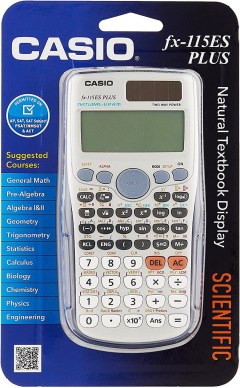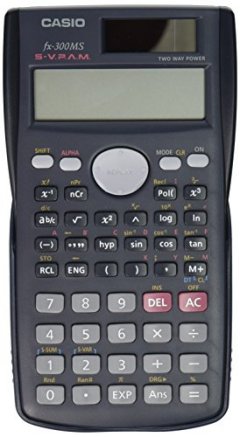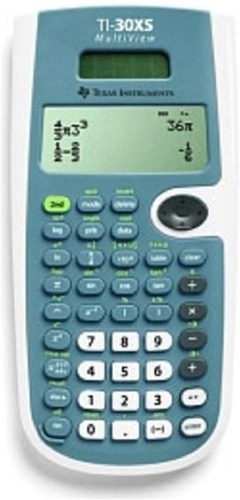BestReviews is reader-supported and may earn an affiliate commission. Details

A top-selling scientific calculator by Texas Instruments that is a handy educational tool for students in introductory algebra and beyond.
A popular calculator ideal for numerous math and science applications, including chemistry, biology, statistics, and algebra. Works well for graphing. Has a spacious screen, pull-down menu, and pre-loaded apps.
Pricey. Learning how it works can be confusing, but the company provides access to web tutorials to help you.

Solid scientific calculator offers plentiful functions at a reasonable price. Great for students or professionals.
Has 280 functions, including fractions, stats, and other calculations. Multi-replay lets you backtrack and edit expressions. Approved for college entrance exams. Solar power backs up batteries.
Buttons may come loose at times. Battery life is short despite solar power backup.

Worth considering if you need a scientific calculator at an affordable price and don't mind that it comes with a few potentially annoying quirks.
Boasts a streamlined build that feels comfortable in the hand, and doesn't add a lot of bulk to bags or book packs. Perfect for algebraic and statistical equations. Falls on the lower end of the price scale.
Buttons have a bit of a flimsy feel. Display is one line. Some owners gripe about the distracting glossy finish.

A durable workhorse with all the features students and financial pros need - for a reasonable price.
Has 240 functions on a 2-line display. Comes with a hard case for protection. Has 9 variable memories and solar power to back up batteries.
No derivative or integral functions. Some people have a hard time reading the screen.

One of the most popular scientific calculators by one of the top brands in the industry. It's also reasonably priced and can tackle numerous math functions, but not all.
Offers both solar and battery power capabilities and a 4-line display. We love the edit, cut, and paste functions. Suitable for basic algebra to geometry and more. Mid-range price.
Reported inaccuracies when using scientific notation. Screen is difficult to see in some low-light settings.

We recommend these products based on an intensive research process that's designed to cut through the noise and find the top products in this space. Guided by experts, we spend hours looking into the factors that matter, to bring you these selections.

What’s the difference between looking up a value in a logarithm table and typing it into your scientific calculator? Speed. Pundits may debate whether a scientific calculator is a tool or a crutch, but at some point in your education, you’re going to need one.
When it comes to functions, variables, equations, and formulas, most of us feel overwhelmed. Understandably, picking out the best scientific calculator can be an intimidating task. And it doesn’t help that there are so many models on the market. Don’t worry, though, because we’re here to help.
At BestReviews, we make shopping pain-free with our thoroughly researched recommendations and detailed shopping guides. Whether you’re buying a scientific calculator for yourself or your child, simply keep reading to learn the difference between calculators, how they are powered, the key features and functions, and how much you can expect to spend.

There are three different types of calculators: basic calculators, scientific calculators, and graphing calculators.
Basic calculators
A basic calculator only performs basic mathematical functions. It can add, subtract, multiply, and divide. It might also be able to figure percentages, square roots, or perform other simple calculations as well.
Scientific calculators
About the time you start getting into algebra, a scientific calculator becomes handy. Even the most basic scientific calculator can handle sines, cosines, tangents, logarithms, and other functions. A more advanced scientific calculator will have multi-function keys – activated by keys that work like the shift and option keys on your computer – and they will be able to solve boolean (true or false) as well as variable equations.
Graphing calculators
A graphing calculator typically has the same problem-solving abilities as a scientific calculator. The only difference is its higher-resolution screen, which allows you to see the solution on a graph.




















Unless you have a desktop adding machine, the days of corded calculators are pretty much over. Today, scientific calculators are either battery-powered, solar-powered, or dual-powered (solar and battery).
Battery power
With all the emphasis on renewable energy sources, it’s pretty hard to recommend a device that uses disposable batteries. An argument could be made for rechargeable batteries, however. The biggest downside to using batteries, besides the environmental concern, is that when your batteries die, you no longer have a functioning calculator. If it happens at an inopportune time, you’re out of luck.
Solar power
If a calculator doesn’t have a lot of electrically demanding features such as printing and graphing – which scientific calculators do not have – then solar power is a great way to go. The cells can charge from natural or artificial light, so your chances of running out of juice are very slim. Unless you store it in a drawer or use a protective cover, a solar-powered scientific calculator could be your best option.
Dual power
Combining both power sources can give you peace of mind. If your batteries run out, you can still use solar power. If two power sources make you feel more secure, a dual-powered scientific calculator is a good option.

There are hundreds of functions on a scientific calculator, so covering all the possible options would be tedious. However, there are a few key features and functions that are quite handy to have in a scientific calculator.
Cover
If you’re going to be tossing your scientific calculator in a backpack or slipping it into your pocket, having a cover, case, or lid to protect the keys and screen can be invaluable.
Design
Design is more than just your favorite color, it’s about how comfortably your scientific calculator fits in your hand and how easy it is to find and press the buttons you use most often. Does the calculator’s layout make sense to you?
Memory
Having a scientific calculator with a recallable memory can make solving a string of equations with a common part appreciably easier to do.
Multi-function keys
Multi-function keys give you the ability to perform two or three functions with the same key. This way, you can solve a wider variety of complex problems without adding any more keys, which keeps the number of buttons on your scientific calculator to a somewhat manageable number.
Multi-line screen
Having a multi-line screen on your scientific calculator allows you to see more of what you entered, which can lessen the chance for a mistake. It can also let you see both the problem and the solution at the same time to allow for greater comprehension of the mathematical concepts involved.
Programmable
If you need to solve a complicated equation for several different values, it helps to have a programmable scientific calculator. Much like a computer, a programmable calculator lets you execute a stored sequence of operations.
Undo
Having an undo feature on a scientific calculator is great for those times you accidentally hit a wrong number. Instead of starting from scratch, just step back through what you did one element at a time to quickly fix the error.
Replay
A replay function on your scientific calculator is like an advanced undo function. It lets you step forward or backward through your calculations to double-check your work. If you find a mistake, you can correct that mistake and solve the equation again without starting over.
Price
Early scientific calculators were large and bulky – think early cell phones – and cost a lot. Today, the price range for a scientific calculator runs from about $10 to $20. You can certainly spend more or less, but this is the sweet spot for both quality and value.

Q. How does a scientific calculator work?
A. Electronic language is binary. That means it is based on two things: on or off. Or, as it is usually represented, ones and zeros. Every key that is depressed is translated into the language that the calculator understands. Using a series of rules and routines, a scientific calculator processes extremely complex computations instantly. The most important part, however, is that the calculator can also translate binary language back into numbers and other characters that are displayed on the screen.
Q. What classes in school require scientific calculators?
A. A scientific calculator starts to become useful in early algebra. It becomes a necessity as you get into more complex levels of algebra. You may also find it helpful in statistics, biology, and chemistry. Although a scientific calculator can also do the math needed for trigonometry, calculus, physics, and engineering, if you need to see a visual representation of an answer in the form of a graph, you will need to use a graphing calculator instead.
Q. Can I use a scientific calculator on the SAT?
A. You cannot use calculators on the SAT that have power cords, a stylus, connect to the internet, or have a QWERTY keyboard. Therefore, a scientific calculator is perfect for the SAT.
Get emails you’ll love.
Learn about the products you’re wondering if you should buy and get advice on using your latest purchases.
